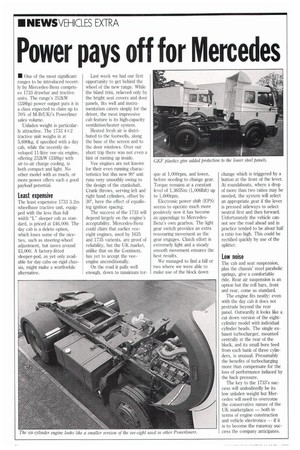Power pays off for Mercedes
Page 20

If you've noticed an error in this article please click here to report it so we can fix it.
• One of the most significant ranges to be introduced recently by Mercedes-Benz comprises 1733 drawbar and tractive units. The range's 252kW (338hp) power output puts it in a class expected to claim up to 70% of M-B(UK)'s Powerliner sales volume.
Unladen weight is particularly attractive. The 1733 4x2 tractive unit weighs in at 5,690kg, if specified with a day cab, while the recently developed 11-litre vee-six engine, offering 252kW (338hp) with air-to-air charge cooling, is both compact and light. No other model with as much, or more power offers such a good payload potential.
The least expensive 1733 3.2m wheelbase tractive unit, equipped with the less than full width "L" sleeper cab as standard, is priced at £46,000. The day cab is a delete option, which loses some of the niceties, such as steering-wheel adjustment, but saves around £3,000. A factory-fitted sleeper-pod, as yet only available for day cabs on rigid chassis, might make a worthwhile alternative. Last week we had our first opportunity to get behind the wheel of the new range. While the bland trim, relieved only by the bright seat covers and door panels, fits well and instrumentation caters simply for the driver, the most impressive cab feature is its high-capacity ventilation/heater system.
Heated fresh air is distributed to the footwells, along the base of the screen and to the door windows. Over our short trip there was not even a hint of misting up inside.
Vee engines are not known for their even running characteristics but this new 90° unit runs very smoothly owing to the design of the crankshaft. Crank throws, serving left and right hand cylinders, offset by 30°, have the effect of equalising ignition spacing.
The success of the 1733 will depend largely on the engine's acceptability. Mercedes-Benz could claim that earlier veeeight engines, used by 1635 and 1735 varients, are proof of reliability, but the UK market, unlike that on the Continent, has yet to accept the veeengine unconditionally.
On the road it pulls well enough, down to niaxiniani tor
que at 1,000rpm, and lower, before needing to change gear. Torque remains at a constant level of 1,365Nm (1,0061bft) up to 1,600rpm.
Electronic power shift (EPS) seems to operate much more positively now it has become an appendage to MercedesBenz's own gearbox. The light gear switch provides an extra reassuring movement as the gear engages. Clutch effort is extremely light and a steady smooth movement ensures the best results.
We managed to find a hill or two where we were able to make use of the block down change which is triggered by a button at the front of the lever. At roundabouts, where a drop of more than two ratios may be needed, the system will select an appropriate gear if the lever is pressed sideways to select neutral first and then forward. Unfortunately the vehicle cannot see the road ahead and in practice tended to be about half a ratio too high. This could be rectified quickly by use of the splitter.
The cab and seat suspension, plus the chassis' steel parabolic springs, give a comfortable ride. Rear air suspension is an option but the roll bars, front and rear, come as standard.
The engine fits neatly: even with the day cab it does not protrude beyond the rear panel. Outwardly it looks like a cut down version of the eightcylinder model with individual cylinder heads. The single exhaust turbocharger, mounted centrally at the rear of the block, and its small bore feed from each bank of three cylinders, is unusual. Presumably the benefits of turbocharging more than compensate for the loss of performance induced by the back pressure.
The key to the 1733's success will undoubtedly be its low unladen weight but Mercedes will need to overcome the conservative nature of the UK marketplace — both in terms of engine construction and vehicle electronics — if it is to become the runaway success the company anticipates.
























































































































